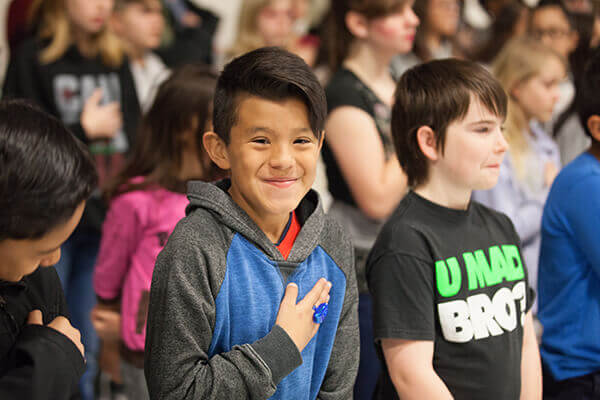Dixon Farewell Open House
April 25th, 2024
Anyone who has attended or worked at Dixon, you are invited to join us for a celebration of...
Spring Creek Elementary, located on the south edge of Provo, is one of Provo City School District’s (PCSD) Title 1 schools. This year, Spring Creek was selected as one of only 63 National Title I Distinguished Schools. This honor is given to schools for either exceptional student performance overall, for significantly closing the achievement gap between student groups or for excellence in serving special populations of students (e.g. Homelessness, migrant, English learners, etc.). The National Title 1 Distinguished Schools Program uses this award to recognize the schools who have successfully utilized their Title 1 funds to catalyze outstanding academic achievements and improvements from their students. Spring Creek was recognized for their high progress scores, which are higher than both the district and state averages.
Spring Creek strives for excellence as they work hard to create many experiences for their students that will help them to enjoy learning, while also working to improve our PCSD’s graduation rates. They begin working toward graduation with students at a young age by emphasizing learning promises, teaching students to be builders of learning, utilizing electronic tracking and visible learning and catalyzing a positive school culture.
One way that Spring Creek works to improve graduation rates early on is by encouraging students to take ownership of their education through learning promises. Principal Jill Franklin states, “What we believe is that, as teachers, we promise to teach kids the best we can and in the way they need so that they can learn.” Students treat each standard that they are supposed to learn as a “promise” and strive to achieve as many promises as they can. By treating these learning standards as promises, students are taking ownership of their education and learning that the things they are learning now are for life.
Currently, Spring Creek is striving to empower parents to help kids practice promises. Every grade level has parent-engagement activities where they not only do a learning activity, but also explain the promises to their parents. The hope is that parents will help students practice these promises at home and understand that teaching at home should look different than teaching at school. Through the year, Spring Creek encourages all to keep their promises, with teachers promising to teach, kids promising to learn and parents promising to support in whatever ways they can.

Students are continually pushed to succeed and take ownership of their learning through Spring Creek’s “builders of learning” model. Through the “builders of learning,” students are taught that they are builders and are given a visual of a tool box with several “learning tools” that will help them succeed. The learning tools include:
Each statement is represented by a physical tool to give students a visual of the power of that statement. For example, “we learn from mistakes” is represented by a screwdriver because the screwdriver has to adjust a screw and, when you learn from mistakes, you are adjusting your life.
Jill says, “Our learning tools are a big part of what I am trying to instill in our students and teachers. When we learn, it is this process. We look at it as a building process: we are building knowledge, we are building dreams, we are building ideas and hopes- so that these kids have that sense of ‘I am a builder’ and ‘I can do this’.”
This tool box is not only displayed and discussed with students, but teachers and staff make sure to utilize this to solve student issues. When a student has a struggle with something, such as behavior, academics, attendance, etc., the adult reminds them of the box.
Jill further emphasizes this by stating, “We have that [tool] box so that the kids know that they have the box all the time and that they carry it in their head. It is you who determines which tool you are going to pull out.”
Not only does this toolbox visual provide solutions to problems, but students also begin to recognize that they are practicing having a growth mindset when utilizing the tool box. Overall, students who recognize that they are “builders of learning” and utilize the learning tools learn how to take ownership of their education and are pushing themselves for success now and in their future.
In the fifth and sixth grade classrooms at Spring Creek, students are taking ownership of their education one step further. Each of these students has been given electronic data notebooks where they create a google presentation with their teacher to track their progress. Teachers give students their scores and the students themselves enter the score into their Google presentation. This practice allows students to see their progress as they can visualize their scores at the beginning of the year and what their scores are currently. They are also able to keep track of what promises they have mastered and what promises are still needing some improvement. Students take ownership of these scores as they share this Google presentation with their parents at parent-teacher conferences.
Teachers are also providing a visual way for students to assess if they have mastered the standards by utilizing learning targets and success criteria in their classroom. Jill took the time to walk through her classrooms and discovered that 95 percent of their classrooms are utilizing this great method. Learning targets are when teachers have a statement on the board that describes what the student should be able to do after that specific lesson. The success criteria are listed below ( different steps that the student can assess themselves with to determine if they have mastered the overall learning target) are listed below the learning target. Utilizing learning targets and success criteria in the classroom allows students own their learning and really be able to determine what specific aspects of the lesson they need more assistance with in order to succeed.
Spring Creek has a very positive school culture, which is most likely because of the excellent teachers, staff, administration, students and Positive Behavior Interventions and Supports (PBIS). The PBIS statement at Spring Creek is “Be kind, Be safe, Be responsible”. This is very heavily implemented throughout the school and, when in the school, you will likely see a sign with this statement around every corner. Through this statement, students are being taught to own their behavior and to recognize what the expectations are at the school. For example, if a student has an issue, they are asked “What is the problem with this behavior? Is it kindness? Is it safety? Is it responsibility?” They can then recognize how their behavior was not in line with the school statement and this enforces positive behavior throughout the school.
This is continually emphasized as different students are selected every Monday and recognized during the morning announcements because of something they did that was safe, kind or responsible. Parents of these children also receive a phone call explaining the positive things that their child did, which helps parents to understand the statement and continue to discuss it with the child at home. There are many other rewards that students can earn through following this PBIS statement such as being entered into the 200 club, where they have the chance to win an opportunity to do an activity with the principal, or being the one student to be recognized on the monthly recognition board.

Spring Creek is a wonderful school which helps students succeed through putting a heavy emphasis on student ownership and progress. It was no mistake that this school was selected as a National Title I Distinguished School, as they are implementing several innovative techniques to help their students succeed and are striving to increase graduation rates at a young age. Principal Franklin says, ‘We have a vision at Spring Creek of continuous growth for all. It says ‘continuous progress for all students on our website, but we have come to realize that, in order for that to happen, then it needs to be continuous growth for all– everyone who is in this building. We also believe that progress is very complex. It is not just about Language Arts or Math, it is how a child feels about themselves and about their education. We really do believe and work for continuous progress for all.”
Anyone who has attended or worked at Dixon, you are invited to join us for a celebration of...
The teachers and specialists in Provo City School District are our innovators They are innovators,...
PCSD LGBTQ+ Advisory Committee Presents: A Night for All Families May 11, 2024, 5-7 PM Grandview...